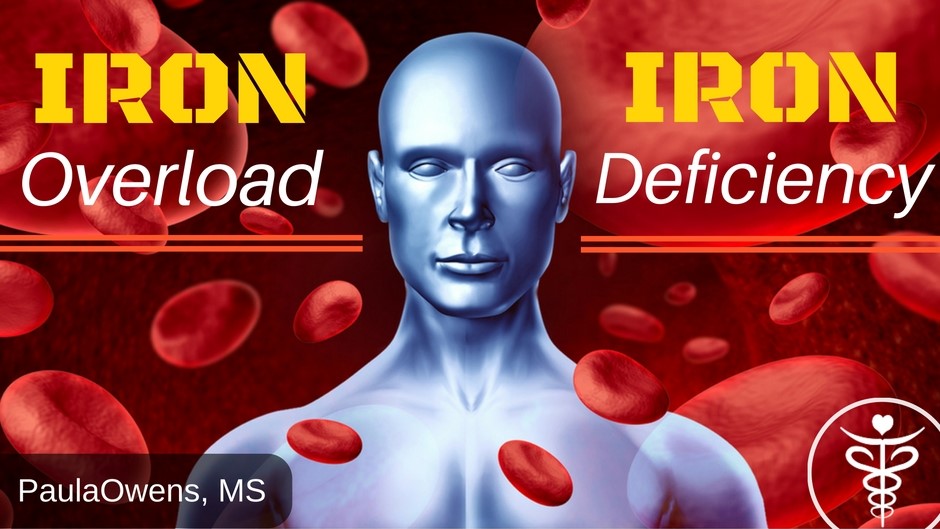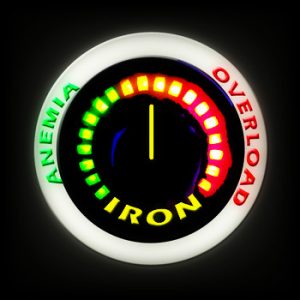Educating and Empowering You to Heal, Thrive, and Live a Happy, Healthy Lifestyle
The Dangers of Iron Anemia and Iron Overload
 Have you been told you’re anemic and automatically think you need more iron? Iron anemia or low iron does not always indicate that you have an actual iron deficiency. What about high iron levels and iron overload?
Have you been told you’re anemic and automatically think you need more iron? Iron anemia or low iron does not always indicate that you have an actual iron deficiency. What about high iron levels and iron overload?
Iron is necessary to carry oxygen from the lungs throughout the body and for other cellular functions. Iron is stored in your muscles, the liver, spleen and bone marrow. Without it, your cells would become starved for oxygen, your brain and muscles wouldn’t function, and your immune system would be impaired and other problems arise from iron deficiency.
 BUT, that doesn’t mean you need to take an iron supplement. In fact, too much iron can be dangerous.
BUT, that doesn’t mean you need to take an iron supplement. In fact, too much iron can be dangerous.
The most important factor is to determine the root cause why your iron levels are too high or too low in the first place. A few years ago, my iron levels were off the chart. The cause? Lead toxicity.
I owe credit for the majority of the information in this article to one of my mentors, Harry Eidenier, Jr., Ph.D., a brilliant researcher, biochemist and scientist, and grandfather of Functional Blood Chemistry Analysis.
Causes of Iron Anemia, Iron Deficiency and Low Iron
“Any attempt to determine iron anemia without a serum iron, ferritin and TIBC is of no avail.” —Harry Eidenier, Jr., PhD
Although this list is lengthy, it’s important to identify the root cause of an iron deficiency and why iron is low, and realize that no two people are alike and each person has a unique biochemistry.
-
Nutrient deficiencies: vitamin C, iodine, B12, folate and B6
- Underlying infections such as Candida overgrowth, SIBO, bacterial infections, intestinal parasites, H. pylori, yeast and fungal infections
-
Gut dysfunction. Intestinal inflammation. Leaky gut. Absorption issues.
-
Hypochlorhydria (low stomach acid). Many individuals are deficient in hydrochloric acid (HCL), which is required to breakdown protein, absorb iron and many other nutrients. An inability to absorb iron is often the most obvious symptom of a much broader problem.
-
Excessive blood loss from heavy menses
-
Prescription and OTC drugs such as Metformin, Synthroid, and NSAIDs such as Tylenol inhibit iron absorption
-
Iron anemia in women may actually be an indication of thyroid dysfunction
-
Antacid use, salicylates, aspirin, NSAIDs, fluoride exposure, excess zinc and calcium supplements inhibit iron absorption
-
Long distance runners
-
Sleep deprivation
-
Chronic stress, adrenal insufficiency
-
Internal bleeding, occult blood and bleeding ulcers
-
Iron anemia is linked to Crohn’s, rheumatoid arthritis, lupus and other autoimmune diseases
-
The Standard American Diet (SAD): starchy carbohydrates, grains, fructose, sugar, processed foods, artificial sweeteners, chemicals, herbicides and pesticides
-
Poorly planned vegetarian diets
-
The Journal of Nutrition published a study showing that polyphenols (grape seed extract and EGCG found in green tea extract) bind to iron in the intestinal cells, which inhibits absorption.
-
Tyrosine deficiency, a commonly overlooked problem with elderly individuals living on the “tea & toast diet” (insufficient intake of protein).
-
Phytates found in legumes and grains, tannins found in tea, coffee, purple grapes, rice, walnuts and cocoa block iron absorption.
-
Eating a non-organic diet. Glyphosate, the key ingredient in Roundup is a major chelating agent, particularly chelating vital trace minerals such as magnesium, manganese, iron, molybdenum and cobalt from the body. Glyphosate has been linked to infertility, leaky gut, autoimmune disorders, neurological disorders, birth defects, ADHD, insulin resistance, altered DNA, accelerated aging, autism and hormone-sensitive cancers.
Symptoms of Iron Deficiency
Fatigue, low energy, dizziness, headaches, nighttime leg cramps, and spoon-shaped finger/toe nails with ridges. A desire to chew ice, eat chalk or dirt, and an inability to tolerate cold weather are common factors associated with iron anemia. Fifty percent of infant anemia is often an allergic condition caused by pasteurized milk that can cause bleeding in the GI tract.
If your iron is low and you are actually diagnosed with an iron deficiency and iron anemia, consider vitamin C, which aids to increase iron absorption. Use cast-iron cookware. Increase consumption of grass-fed red meats, oysters, clams, sardines, organ meats, pastured eggs (especially the yolks), black strap molasses, and chlorophyll-rich foods such as spinach and dark leafy greens.
Iron Overload — Hemochromatosis
Most men and postmenopausal women are at risk for iron overload due to age and inefficient iron excretion. Because of the health risks associated with high iron levels, men over 40 and woman over 50 should have their serum iron, TIBC and ferritin levels checked annually.
As we age, iron can accumulate in organs like the brain, liver, pancreas and heart. This is dangerous! Excess iron accelerates aging by creating oxidative stress, which increases glycation, causes mitochondrial cell damage and unwanted DNA changes.
Iron overload has been linked to arthritis, fatty liver disease, metabolic syndrome, type 2 diabetes, breast, colon and prostate cancer, heart disease, thyroid disease, heart arrhythmia, liver damage, and Alzheimer’s disease. Sadly, the dangers of high iron are often overlooked.
What Causes Iron Overload?
Possibilities of HIGH Iron and factors to rule out
-
The risk of developing excess iron levels increase with age
-
Alcohol consumption, heavy alcohol use, alcoholism
-
OTC and prescription drugs, NSAIDs, oral contraceptives and taking supplements that contain iron can increase iron levels
-
Hemochromatosis (a hereditary disorder in which iron is excessively absorbed in the liver, pancreas and other organs). Those with hemochromatosis often have genetic mutations that predispose them to hemochromatosis
-
Viral infections (hepatitis, HPV, Epstein-Barr, CMV, mono)
- Intestinal permeability aka leaky gut resulting in increased absorption of iron
- Hidden infections. Pathogenic microbes thrive in an iron-rich environment
- Multiple blood transfusions
-
Liver, biliary, gallbladder, or spleen dysfunction
- Impaired bile acid conjugation
- Non-alcoholic fatty liver disease (NAFLD)
-
Nutrient deficiencies: zinc, copper, molybdenum
High iron, iron overload and hemochromatosis are silent killers.
Signs and Symptoms of Iron Overload
While the symptoms are often silent in the early stages of hereditary hemochromatosis or iron overload, as it progresses it can lead to:
- Fatigue, low energy
- Heart arrhythmia, heart disease, atherosclerosis, coronary artery disease, stroke
- Diabetes, high blood sugar
- Hypothyroidism. High iron significantly decreases the bioavailability of thyroxine (T4), which can lead to thyroid dysfunction
- Hormonal problems, hormonal imbalances, early menopause, damaged adrenals
- Loss of libido
- Erectile dysfunction
- Infertility
- Impotence
- Pancreatitis
- Liver disease, enlarged liver, elevated liver enzymes (ALT, AST, GGT), liver cirrhosis
- Yellowing of the skin, hyperpigmentation of the skin and bronzing of the skin
- Joint pain
- Headaches
- Weakness
- Nausea
- Abdominal pain
- Osteoporosis
- Osteoarthritis
- Hair loss
- Depression
- Oxidative stress, glycation and cellular aging (increased ferritin or increased iron are known free radical initiators that damage neurons in the brain and increase risk of cancer)
- Poor memory, dementia, cognitive decline and neurodegenerative brain disorders including Alzheimer’s disease and Parkinson’s
- Breast cancer. Researchers are concluding that high iron is an early breast cancer detection based on the tendency of cancer cells to accumulate iron.
- Increased risk of cancer. High iron is a common finding with colon cancer, colorectal cancer, prostate, breast, liver and lung cancer
How to Lower Ferritin and Reduce High Iron
-
Donate blood 3-4 times per year to lower ferritin levels and remove excess iron, especially if the serum ferritin value is >100 or the transferrin saturation value is >35%.
-
Therapeutic phlebotomy (Rx prescribed bloodletting to donate blood more frequently)
-
Switch from using cast-iron cookware and instead opt for stainless steel, glass or ceramic cookware
-
Heal the gut with the 5-step gut healing formula. Leaky gut and inflammation result in an increased absorption of iron.
-
Avoid processed foods, iron-enriched foods, and all grains including cereals and breads “fortified” with iron.
-
Avoid supplements with iron, vitamin C, citric acid, lysine, histidine, cysteine and methionine.
-
Test for and rule out heavy metal toxicity (lead, mercury, aluminum, cadmium, arsenic)
-
Consume copper-rich foods such as oysters and shrimp. A copper deficiency causes tissues to retain excess iron. Never consume raw shellfish because it may contain a bacteria called Vibrio vulnificus that can be deadly to those with high iron levels.
-
Avoid combining iron-rich foods with vitamin C-rich foods. Combine them with calcium-rich foods instead to limit absorption.
-
Avoid acetaminophen (Tylenol)
-
Reduce, minimize or limit alcohol consumption, which will increase the absorption of iron in your diet.
-
Drink organic coffee to reduce iron’s toxic effects. Coffee can reduce the absorption of iron
-
Install a reverse osmosis water filtration system. Avoid well water.
- Consider a curcumin supplement to reduce iron. Curcumin acts as a potent chelator of iron and can be a useful supplement if your iron is elevated.
-
Optimize liver function. Consider nutrients for liver and gallbladder support, and other supplements that support natural chelation of iron and heavy metals
-
Journal of Nutrition published a study showing that polyphenols (grape seed extract and EGCG found in green tea extract) reduce iron absorption.
-
Rule out zinc deficiency with the zinc taste test and serum alkaline phosphate values via the Blood Chemistry Analysis
Functional Blood Chemistry Analysis
-
Serum ferritin measures the amount of stored iron in the liver, spleen and bone marrow, and is the second most abundant iron-bearing protein in the body. For every 1% increase in ferritin levels, your risk for cardiovascular disease increases by four percent! If your ferritin levels are low, this is an indication that your iron levels may also be low.
-
Serum iron (optimal ranges are 50-100 mcg/dL). Iron and total iron binding capacity (TIBC) are used to calculate the TS% (transferrin-iron saturation percentage).
-
TIBC percent of saturation is the gold standard lab test for the diagnosis of iron overload. A practical way to determine how much iron a person has in his/her body is to use blood tests called “serum ferritin” and “transferrin saturation.” TIBC is frequently increased with the use of exogenous estrogen.
- An increased GGT (a liver enzyme) can also be used as a screening marker for excess free iron.
If your blood test results indicate ferritin and iron levels that are either too high or too low, contact my office. I will determine the root cause, why your iron, ferritin and TIBC are out of range, and restore balance and iron values to a healthier, optimal and functional level. Be Smart! Balance Your Body Chemistry with Nutrition through a Functional Blood Chemistry Analysis!
Related Posts

